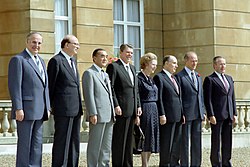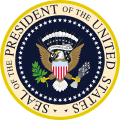| 10th G7 summit | |
|---|---|
 Lancaster House in London | |
| Host country | United Kingdom |
| Dates | June 7–9, 1984 |
| Venue(s) | Lancaster House |
| Cities | London, England |
| Follows | 9th G7 summit |
| Precedes | 11th G7 summit |
The 10th G7 Summit was held in London, England, United Kingdom from 7 to 9 June 1984. The venue for the summit meetings was Lancaster House in London. [1]
Contents
- Leaders at the summit
- Participants
- Issues
- Gallery of participating leaders
- Core G7 participants
- See also
- Notes
- References
- External links
The Group of Seven (G7) was an unofficial forum which brought together the heads of the richest industrialized countries: France, West Germany, Italy, Japan, the United Kingdom, the United States, Canada (since 1976), [2] and the President of the European Commission (starting officially in 1981). [3] The summits were not meant to be linked formally with wider international institutions; and in fact, a mild rebellion against the stiff formality of other international meetings was a part of the genesis of cooperation between France's president Valéry Giscard d'Estaing and West Germany's chancellor Helmut Schmidt as they conceived the first Group of Six (G6) summit in 1975. [4]










